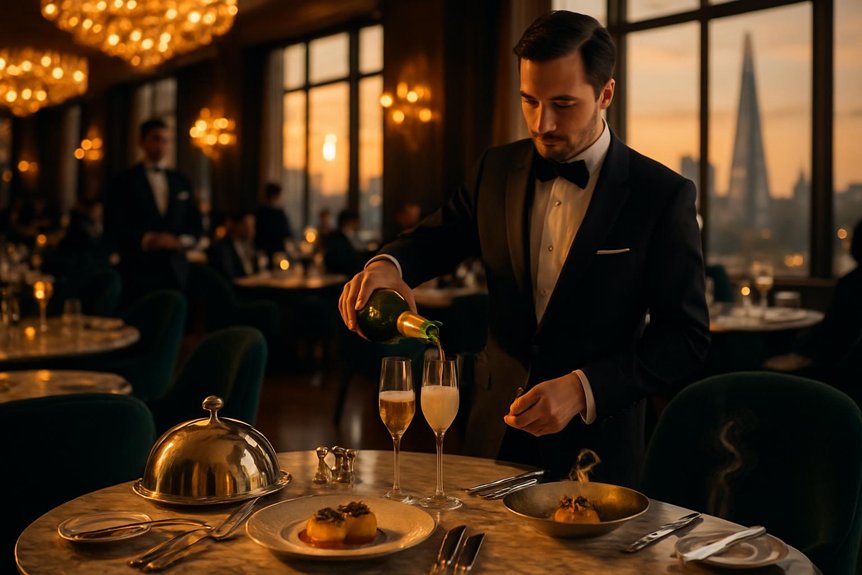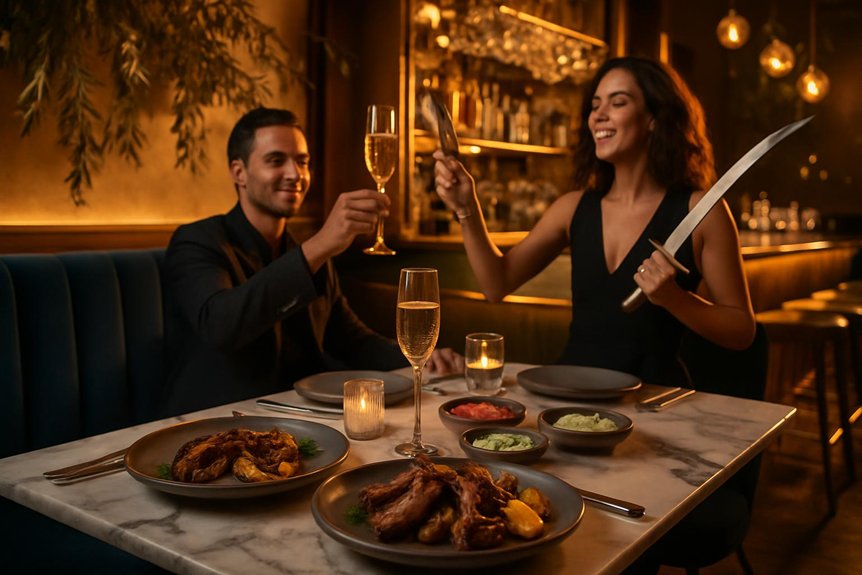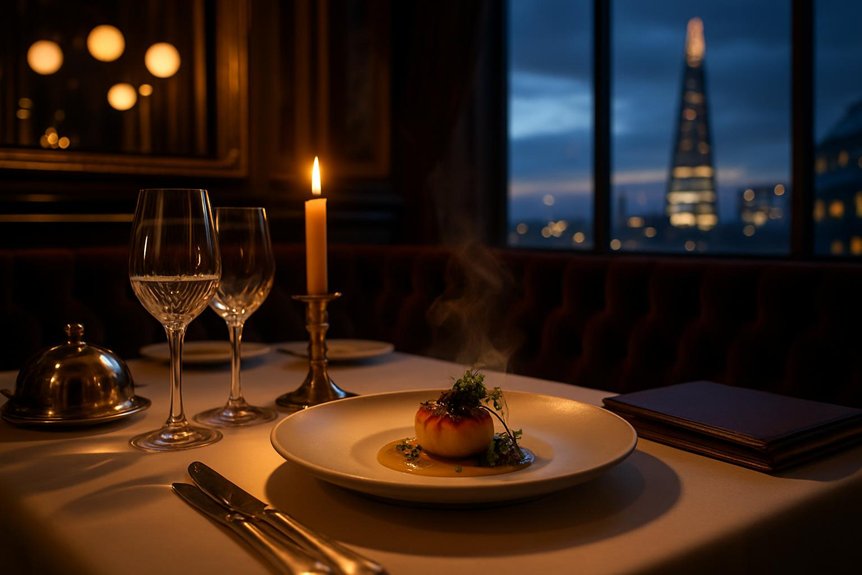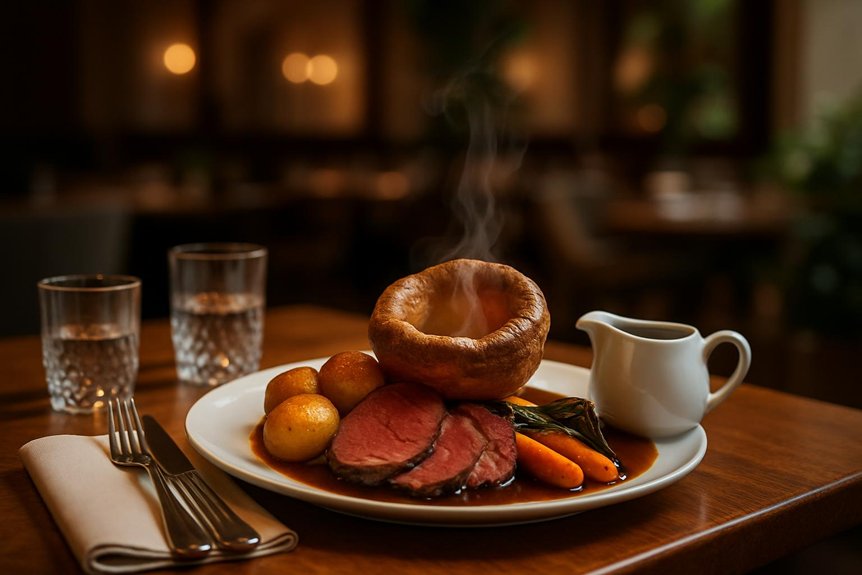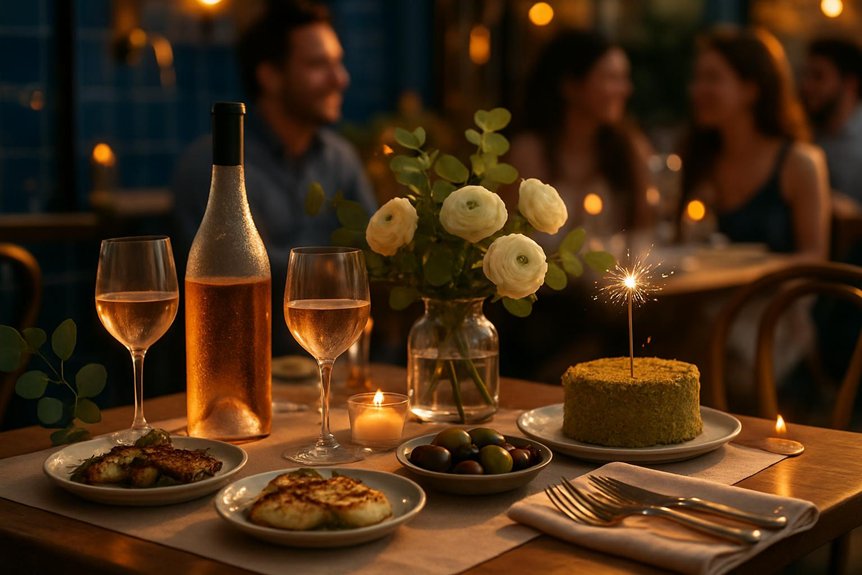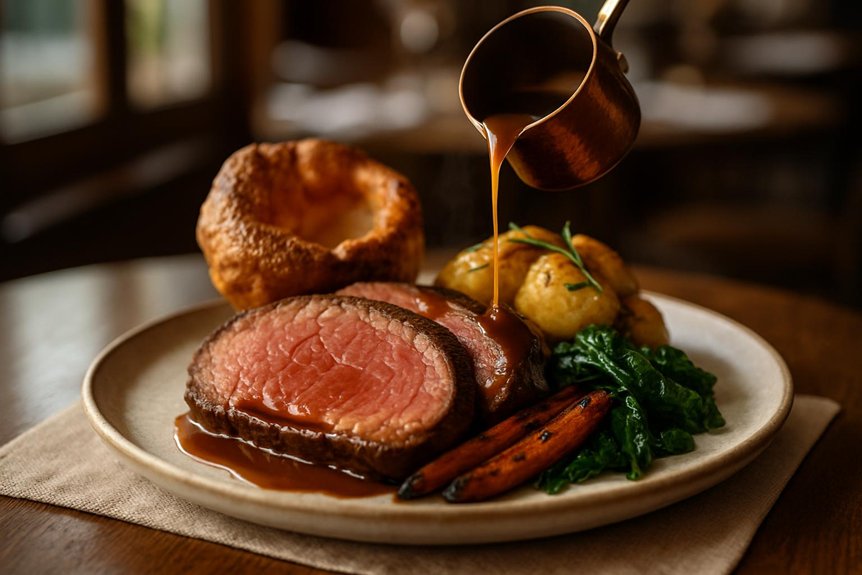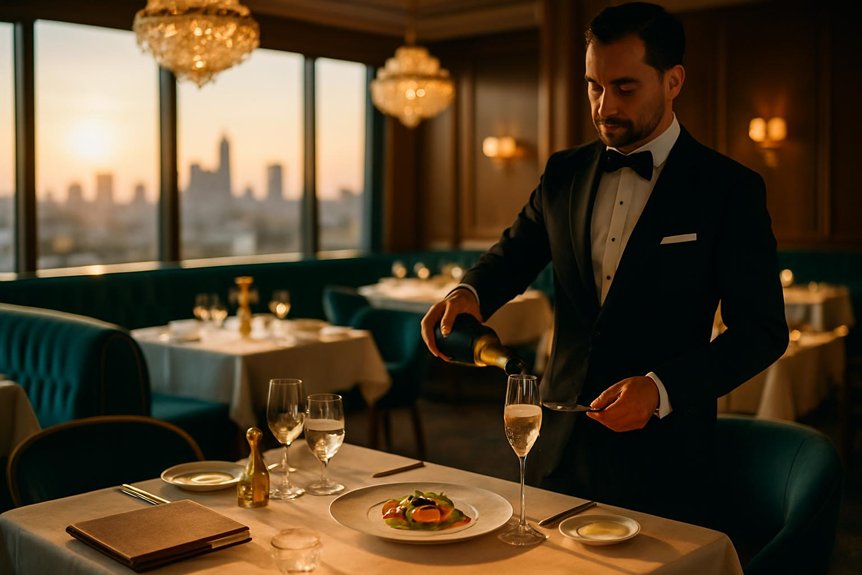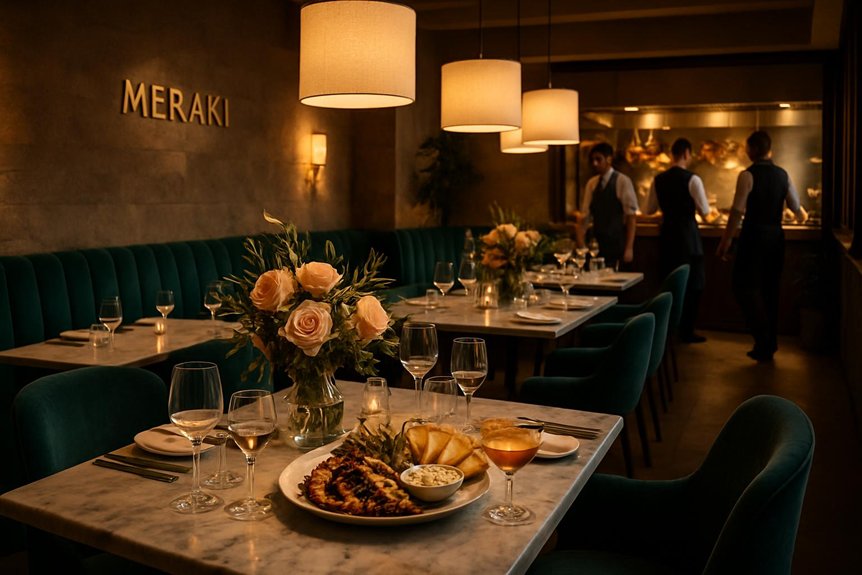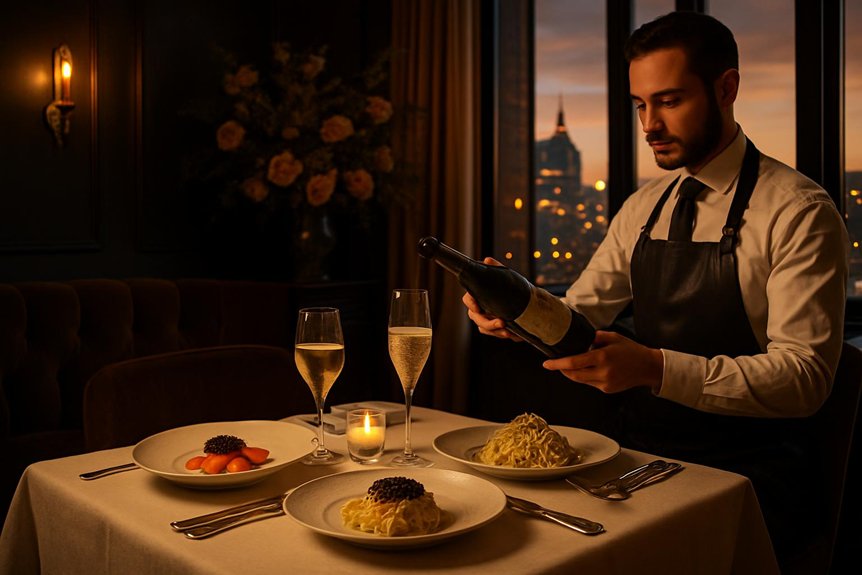London’s luxury restaurants set a measured standard for excellence. Michelin-starred kitchens apply modern technique to pristine British produce. Chef’s tables and discreet counters offer rare access without spectacle. Dramatic interiors frame calm, precise service. Menus lean seasonal, with coastal seafood and heritage meats at the forefront. Wine programs reward curiosity and restraint. From Mayfair’s grand rooms to Shoreditch’s hidden gems, the scene favors craftsmanship over flash—yet the most telling details appear course by course.
Michelin-Starred Icons Worth the Hype
Few cities match London’s concentration of Michelin-starred destinations, and several stand out for delivering substance beyond the star. A handful of rooms remain essential for benchmark cooking, polished service, and cellars that reward curiosity.
The city’s molecular gastronomy temples use technique to heighten flavor rather than distract, pairing playful textures with precise seasoning and disciplined pacing. Elsewhere, classic French inflections meet British produce, proving longevity can coexist with modernity.
Celebrity chef spots justify their reputations when signatures evolve: tasting menus shift with the market, sauces are reduced to shimmering clarity, and desserts show balance instead of bravado. Interiors are plush without becoming theatrical. Reservations are competitive, yet experiences feel measured, from bread courses to mignardises, ensuring diners remember cuisine before spectacle. Additionally, places like Meraki in Fitzrovia offer innovative cocktail scenes that blend tradition with modernity, further enriching the city’s culinary landscape.
Discreet Chef’s Tables and Counter Experiences
London’s luxury scene now turns to discreet chef’s tables and counter-only formats, where hidden omakase counters set a hushed tone.
Guests experience intimate chef interactions that reveal technique and intent in real time. Seasonal tasting exclusives anchor these seats, with micro-menus shifting nightly to reflect peak ingredients.
For those seeking vibrant nightlife, Meraki Restaurant offers a unique blend of dining and dancing, creating an unforgettable experience in the heart of London.
Hidden Omakase Counters
Behind unmarked doors and minimalist facades, a handful of London kitchens hide intimate omakase counters where a chef’s knife work and produce take center stage. These hidden omakase rooms limit seats to a few stools, pacing courses with quiet precision and seasonal restraint.
Diners book discreetly, then surrender to a secret tasting sequence that moves from pristine sashimi to charcoal-kissed morsels, each bite calibrated for temperature, texture, and umami.
Provenance drives the experience: day-boat fish, peak-condition sea urchin, freshly grated wasabi, and rice tuned by vinegar and warmth. Lighting stays low, music subdued, the focus kept on cadence and craft.
Prices reflect scarcity and mastery, yet value lies in control—discipline, timing, and an unwavering respect for ingredients guiding every course.
For those exploring different cuisines in London, the Kima’s contemporary menu offers a Greek twist with a fin-to-gill no-waste approach, emphasizing sustainable seafood practices.
Intimate Chef Interactions
A discreet chef’s table or counter seat narrows the gap between kitchen and diner, turning service into a quiet exchange of intent. Here, choreography replaces spectacle: a garnish explained in a sentence, a flame flashed and gone. Chefs read posture, pace courses, and recalibrate seasoning in real time. Soft-spoken servers translate technique without intruding, while sommelier secrets surface as off-list pours that match fleeting aromas from the pass.
Conversation remains low-key but pointed. Questions about provenance invite brief, exacting replies; knives glide, tweezers settle herbs, and plates arrive with purpose. Dessert dialogues continue the intimacy: a tartness adjusted, a final infusion steeped tableside.
The setting privileges attentiveness over theater, allowing London’s finest kitchens to reveal craft at whisper distance.
Seasonal Tasting Exclusives
How else to frame luxury than by timing it to the fields and tides? In London, seasonal tasting exclusives unfold at discreet chef’s tables and intimate counters, where ingredients dictate tempo and form. Reservations reveal micro-menus that pivot nightly, translating the city’s cosmopolitan palate into precise farm to table narratives.
At these seats, chefs compose courses in real time: day-boat shellfish with hedgerow herbs, or a fleeting truffle broth clarified at the pass. Fusion cuisine appears as quiet dialogue—Nordic smoke meeting Japanese acidity, British game offset by yuzu or koji. The experience favors brevity and focus, minimizing ornament to highlight provenance and technique.
Guests witness sourcing, preparation, and plating as one continuum, a limited run that disappears when the season turns.
Design-Led Dining Rooms With Drama
Sleek spaces with theatrical intent define London’s most design-led dining rooms, where architecture, lighting, and materiality drive the experience as much as the menu. Here, interior architecture sets tone and tempo: vaulted ceilings frame sightlines, mirrored planes elongate rooms, and sculptural staircases choreograph arrival.
Ambient lighting is calibrated like stagecraft—concealed LEDs graze stone, pendant constellations punctuate banquettes, and shadow plays heighten intimacy without obscuring detail.
Palette and texture deliver impact. Lacquered woods, veined marble, and patinated metals create depth, while upholstery in saturated hues anchors zones for cocktails, conversation, and ceremony.
Art installations double as focal points, shifting mood across courses.
Acoustics are engineered to soften clatter, isolating table talk.
The result is immersive dining, defined by form, flow, and controlled spectacle.
The Finest British Produce on the Plate
London’s top dining rooms foreground a seasonal sourcing ethos, letting the calendar dictate what reaches the pass.
Menus spotlight heritage meats—from rare-breed beef to mutton—handled with precision to preserve character and depth.
Coastal seafood arrives at peak freshness, translating Britain’s shores into clean, exacting plates.
Seasonal Sourcing Ethos
In a city famed for cosmopolitan tastes, the most lauded dining rooms return to Britain’s larder with purpose. Their seasonal sourcing ethos is exacting: chefs map planting calendars, reserve micro-harvests, and build menus around brief windows of excellence. This disciplined farm to table approach privileges proximity and provenance, reducing food miles while elevating flavor integrity.
Sustainable sourcing underpins the model. Buyers cultivate small-network relationships with coastal day boats, biodiverse market gardens, and regenerative dairies, ensuring traceability and steady standards.
Menus pivot weekly—sometimes daily—so diners encounter prime asparagus in late spring, hedgerow berries at midsummer, and game-friendly roots as frosts arrive. Preservation techniques—pickling, curing, fermenting—carry peak-season brightness across the year, allowing luxury restaurants to showcase British terroir with restraint, precision, and environmental accountability.
Heritage Meats Showcased
A discerning reverence for heritage breeds defines the city’s most exacting kitchens, where provenance is treated as craft. Menus spotlight heritage meats sourced from rare-breed farms, their flavor profiles deepened by slow growth and pasture-led diets.
Chefs lean on traditional butchery to liberate texture and character—seam-boned sirloin, densely marbled mutton, and native pork aged to a nutty sweetness. Saucing is restrained, garnishes precise, ensuring breed expression remains central.
Dry-aging, ember-roasting, and low-temperature resting deliver clarity, not bravado. Service teams narrate lineage and maturation, turning each cut into a lesson in terroir and time.
- Breed integrity over novelty: flavor earned through patience
- Craft preserved: traditional butchery as culinary backbone
- Measured technique: heat, age, and salt revealing honest depth
Coastal Seafood Excellence
From cold, tidal waters to plate, the city’s sharpest dining rooms prize British coastal catch handled with elemental restraint. Menus read like tide charts: day-boat scallops, native oysters, line-caught turbot, and sweet Cornish crab arrive with minimal interference, honoring Coastal freshness over spectacle.
Saucing is judicious—seaweed butters, citrus oils, and fennel broths—allowing mineral purity to lead.
This is Harbor cuisine translated for white-linen rooms: grilled langoustine with smoked dulse, brill roasted on the bone, cockles sharpened by samphire and cider. Provenance appears as quietly as the plating: Skye, Orkney, Dorset, Brixham.
Chefs deploy precise heat, immaculate timing, and exacting sourcing to capture briny snap and delicate texture. The result is luxury measured not by embellishment, but by the ocean’s unbroken voice.
Tasting Menus for Culinary Adventurers
Why do London’s most ambitious diners seek out tasting menus? Because these concise narratives of flavor offer progression, precision, and surprise. Chefs compress months of research into sequences that move from bracing canapés to refined finales, revealing technique and terroir without excess.
In a city fluent in fusion cuisines, courses might pivot from yakitori-glazed eel to miso-buttered langoustine, then slip into a deft vegetarian tasting that treats beetroot, kombu, and smoked walnut like headline acts. Portions remain disciplined; pacing is choreographed; presentation serves purpose.
- Curiosity rewarded: tasting menus reduce risk by concentrating the chef’s strongest ideas.
- Time as luxury: courses map a journey, letting diners witness seasonal thinking.
- Ethics elevated: plant-led or vegetarian tasting options prove indulgence can be conscientious.
World-Class Wine Lists and Pairings
Precision on the plate invites equal rigor in the glass. At London’s luxury tables, wine programs function as parallel narratives to the cuisine, designed with forensic attention to terroir, structure, and seasonality.
Head sommeliers orchestrate wine pairings that highlight texture—acid against richness, tannin against char, umami with age. Cellars span benchmark regions and emergent producers, with vintage selection calibrated to maturity windows rather than prestige alone.
Tasting flights often progress from saline Champagnes to mineral-driven whites, then poised reds and contemplative sweet wines.
Lists emphasize transparent sourcing, pristine storage, and meticulous service temperatures. Guests encounter verticals that map a vineyard’s arc, alongside by-the-glass rarities via Coravin.
The result is choreography, not ornament: bottles curated to echo technique, amplify flavor, and conclude the experience with polished restraint.
Neighborhood Gems From Mayfair to Shoreditch
London’s patchwork of neighborhoods hides a cohort of quiet standouts, where polished technique meets local character without white-tablecloth theatrics. In Mayfair, discreet dining rooms pair seasonal British produce with hushed hospitality, steps from historic landmarks and galleries.
Marylebone leans into intimacy: chef-led counters, restrained plating, and clever vegetable work. Soho trades in small plates with high-impact flavor, a cosmopolitan echo of its late-night pulse.
East to Shoreditch, urban chic defines the mood—contemporary fire kitchens, boundary-pushing tasting menus, and natural-leaning cellars set against brick-and-neon grit. Clerkenwell and Spitalfields supply craft-forward bakeries-turned-bistros and wine bars where reservation books fill fast.
- Neighborhood prestige influences menu ambition and price elasticity
- Heritage settings amplify perceived luxury without ostentation
- Local producers anchor refinement to place, sustaining culinary identity
Conclusion
In a city where more than 70 Michelin stars sparkle, London’s luxury dining scene rewards curiosity as much as pedigree. From hushed chef’s counters to theatrical rooms drenched in light, each experience ties craftsmanship to provenance—day-boat seafood, heritage meats, and deftly sustainable sourcing. Tasting menus push boundaries without losing British identity, while sommeliers choreograph wines with rare precision. Whether in Mayfair or Shoreditch, the promise remains: meticulous technique, intimate storytelling, and a reason to return before the season turns.
